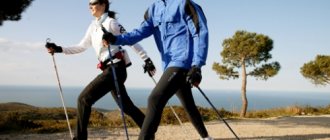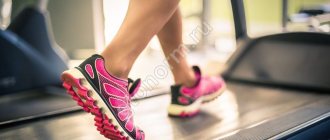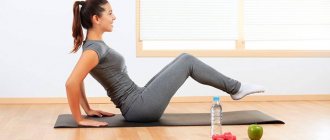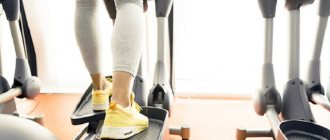Walking in place is one of the most accessible and popular physical exercises, which has virtually no contraindications. Its main advantage is the zero risk of injury and the simplest execution technique. Any beginner can master the exercise, without the help of a trainer or even Google. You can walk everywhere: at home, on the street, and in the office, right during a break. Thus, any person will be able to lead an active lifestyle, even those who have absolutely no time for the gym or morning exercises.
How many calories are burned
Let's answer the main question that interests all women who are trying to walk in place to lose weight - how many calories are burned?
On average, you will spend 250-500 kcal during an hour-long workout. The exact amount depends on the intensity of walking - the faster you move, the more energy you will spend. The recommended rhythm for beginners is 70 steps per minute. Continuing athletes should move at a speed of 90-100 steps per minute. For experienced ones, we recommend having time to take 130-150 steps, that is, practically running in place.
So we've figured out how many calories you burn when walking in place, but what if you want to increase your burn? Is there any way to increase the load?
When, how and how much to go
Walking for health is based on three principles:
- "Do no harm". The intensity and duration must correspond to the state of the body.
- Gradualism. The pace, time and duration increase without sudden stress on the body.
- Regularity. The ideal frequency of walking is daily. An acceptable option is 3-4 times a week for at least 30 minutes.
When to go
Always. Including the route to and from work. If work is far away, train yourself to walk several stops. Morning exercise invigorates you before a working day, evening exercise strengthens your sleep.
In summer it is better to go in the morning or evening hours; In winter, frost stimulates a fast pace, which means a good load on the body (excluding abnormal temperatures).
How and how long to walk
Depends on your physical condition. An untrained body will get exercise from walking (4 km/h, low intensity, comfortable speed, heart rate does not exceed 80 beats/min.). Duration from 20 min. at the first stage up to 30-40 minutes. in a few weeks/months.
The duration of walking to achieve a healing effect is from 35 minutes (pace up to 7 km/h, pulse - 65-80 beats/min.). This is an accelerated, training walk that gives a healing effect. The benefits of fast walking are as follows:
- the risk of heart and vascular diseases is reduced;
- body weight decreases;
- blood pressure stabilizes;
- physical endurance improves;
- The aerobic capacity of the body increases.
The duration of the stage is from several months to a year, until the intensity of walking 6-10 km stops tiring. Next, maintaining physical fitness, including regular exercise walking.
Variations of the exercise
- Try to pick up dumbbells of 3-5 kg each. You can safely add another 150 kcal to your consumption;
- Place a small bench and simulate the ascent and descent of walking on stairs. Plus 300 kcal. Well, or you can always go out into the entrance and run up the stairs;
- You can walk in place using the interval principle - alternating a high pace with a slow one. In this case, the energy consumption of the exercise increases by 200 kcal;
- Do high knee raises. Plus 200 kcal.
How to exercise correctly
Walking in place is an exercise for home; it does not require any specific skills, exercise equipment, or special clothing. Just buy comfortable sneakers and choose a shape that makes you feel comfortable.
Before starting class, stretch your joints and muscles and do short exercises. The last meal should be no closer than 2 hours ago. The average time for one workout is 40 minutes.
- Stand straight, place your feet shoulder-width apart, bend your arms at the elbows, look forward;
- Pull your shoulders back slightly, chest open;
- At a time, lift one knee up until your thigh is parallel to the floor. The opposite elbow goes forward, the other, respectively, back;
- Place your foot on the floor on two, lift the other knee, change the position of your elbows;
- Continue with the diagram. The foot is first placed on the toe, then gently rolled onto the heel;
- The body remains straight throughout the entire “walk”.
If you are trying to perform a high hip raise, aim to touch your chest with your knee. At the same time, maintain a straight back position, that is, do not bend your body towards your knee.
Many people ask what is the benefit of walking in place with the knee raised - we will answer: this way you increase the load and additionally use the abdominal muscles.
Breathe evenly, measuredly, rhythmically. The recommended pace is to inhale and exhale on the same leg.
So, we have discussed the description of the walking exercise for home, but in order to better understand its physics, let’s list what muscles it uses.
Possible harm from walking on your knees
If you follow all the rules, the risk of harming your knees is minimal. Your movements should be smooth - joints “don’t like” sharpness. Before walking, you can warm them up a little with your hands to increase blood flow and synovial fluid production.
Under no circumstances should you put excessive pressure on your knees or walk on hard and bumpy surfaces, as this can lead to injury. If you are overweight, it is better not to lift your hips too far off the floor so that your knee joints do not fall down sharply. Be sure to maintain balance; if necessary, keep your body straight, move your arms slightly bent at the elbows to the sides.
Possible complications of this exercise:
- increased knee pain;
- the appearance of hyperemia and swelling;
- motor restrictions;
- relapses of arthrosis, osteochondrosis of the lumbosacral region.
In the first weeks of starting to walk on your knees, the pain may intensify. If the pain is moderate, is not accompanied by restrictions in leg movements and does not cause exacerbation of chronic diseases of the musculoskeletal system, you should not stop exercising. If severe pain occurs, walking on your knees is contraindicated. It is better to start exercising during the period of remission of knee joint diseases.
Walking for weight loss
Everyone is interested in whether walking in place is good for losing weight; reviews on the Internet are very mixed. We will answer you immediately and very honestly. Walking in place alone is unlikely to make your figure ideal in a short time. However, it will tone your muscles, prepare them for a higher load, and help you find the strength to go to the park on a treadmill or finally go to the gym.
To lose weight, you need to burn more calories than you consume. Accordingly, it is important to monitor your diet and lead a healthy lifestyle. Try to take at least 10,000 steps a day, and to control your counting, install any fitness app on your smartphone.
Walking in place at home will not allow you to quickly lose weight, but, with due diligence and diligence, it will definitely make you look better. The final result depends on the initial parameters, as well as on the time you spend on classes.
Try to spend every free minute exercising. For example, watching a TV series in the evening can be combined with a workout.
What is the benefit of walking in place? Do you need to walk a lot in the morning or can you do it in the evening?
It is very important to mention the fact that walking in place is allowed for absolutely each of us and has virtually no contraindications - this is, of course, the advantage of this activity. The only limitation may be the duration of walking - for those who, due to injuries or illnesses, are prohibited from prolonged stress on their legs.
In combination with proper nutrition, walking in place can help maintain muscle tone (especially in the lower body). This exercise also strengthens the respiratory system and maintains overall health - after all, even minor physical activity is healthier than lying on the couch.
Is it necessary to exercise in the morning? You can practice walking both in the morning and in the evening; basically, the choice of time of day for exercise is determined by the characteristics of the body and your daily routine.
In the process of walking in place, metabolism is normalized due to the release of heat and energy. As many people know, accelerated metabolism is the best assistant for losing weight.
Who is it suitable for?
The walking in place exercise is perfect for beginner athletes who have absolutely no experience in the sports field. The load is considered gentle (about the same as Nordic walking), therefore, it is not prohibited during pregnancy, as well as in old age. Walking in place is practiced by athletes recovering from injuries who are prohibited from other types of exercise. This exercise is recommended for obese people for whom running and other types of walking are prohibited for medical reasons.
Benefits and harms
It's time to find out whether walking in place is useful and what its main advantages are!
- The exercise affects 80% of the muscles of the human body. Let only the buttocks and legs receive the main load, but the whole body is toned!
- Due to active movements, blood circulation and oxygen supply to every cell of the body improves. Vital redox processes are launched, metabolism improves;
- The cardiovascular and respiratory systems are strengthened;
- The fat burning process starts, waste and toxins are removed;
- The athlete's endurance threshold increases;
- Your mood improves and stress goes away.
Walking in place is unlikely to harm anyone. Unless you start exercising while in a state where, according to medical conditions, you can only lie down. Be careful with injuries, damage to the joints of your legs or spine, and never exercise if you feel unwell. This applies to older people, pregnant women, and ordinary young athletes who, for example, have a fever or an upset stomach.
So, we have studied the benefits and harms of walking in place, and at the end of the publication we will provide an approximate training program that is suitable for both beginners and intermediate athletes.
What muscle groups “work”?
Walking on your knees is a Taoist practice that is popular today not only in China but throughout the world. Doctor of Medical Sciences, Sergey Mikhailovich Bubnovsky, has been treating and rehabilitating patients with arthrosis, osteochondrosis and other diseases of the musculoskeletal system for many years, and he also recommends using kneeling walking as one of the available methods of treatment and prevention. This method helps to increase lubrication, and it is precisely because of its lack that acute and chronic joint pain appears.
Walking on your knees works different muscle groups:
- hip flexor and extensor muscles;
- gluteal muscles;
- calf muscles;
- lower back muscles;
- intercostal muscles.
The main load during the exercise falls on the muscles of the thigh and buttocks, as well as on the hip joints. The muscle tissue of the lower back is well used. The degree of loading of individual muscle groups depends on the tactics of performing the exercise.
Training program
For beginners, we recommend training 5-7 times a week for 40 minutes at an average pace. As soon as you feel that this load no longer forces you to work hard, move on to intensive exercises:
- For the first 10 minutes of training, walk at a speed of 80 steps per minute;
- Next, perform steps with high knees for 5 minutes;
- For the next 10 minutes, continue walking at a speed of 100-120 steps per minute;
- Again 5 minutes with high knee raises;
- 10 minutes at a speed of 70-80 steps per minute.
If you are interested in what walking in place with intervals does, we will answer, first of all, increasing the load. You will burn more calories and make your muscles work harder. Accordingly, you will achieve better results in a shorter time.
For athletes who find this load insufficient, we recommend putting a backpack with weight on your back or picking up dumbbells. Or, alternate interval walking with running in place. A scheme that has proven itself to be excellent is alternating regular steps with half-squats or going up an elevation.
Friends, walking in place is a great exercise that allows you to tone your muscles. It does not require visiting the gym, and a person learns the movements themselves at the age of one. This is the easiest and most convenient way to get yourself moving, even in extremely busy times!
Fast walking in place with weights for weight loss
This option of walking in place is considered more difficult in terms of physical activity. You can resort to it if, during a long daily walk in place without additional weight, you begin to notice that the weight has stopped leaving you, and your body has become accustomed to such a load. If you need to continue the process of losing weight, weights in the form of dumbbells that you can simply pick up, special pads of the required weight that you put on your legs, or any other additional load on your shoulders or back, come to the rescue.
As the muscles get used to the next weight, it can be increased with the help of other weights.
The technique of walking in place with weights anywhere (in the arms, on the shoulders, on the back or on the legs) remains the same, we simply add additional weight. The only thing that may change here is the walking time for the first few days. Most likely, it will be difficult for you at first to maintain the same walking time that you did without weights, so it is recommended to reduce the duration of one approach by 5-10 minutes.











